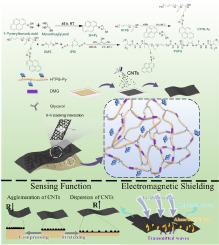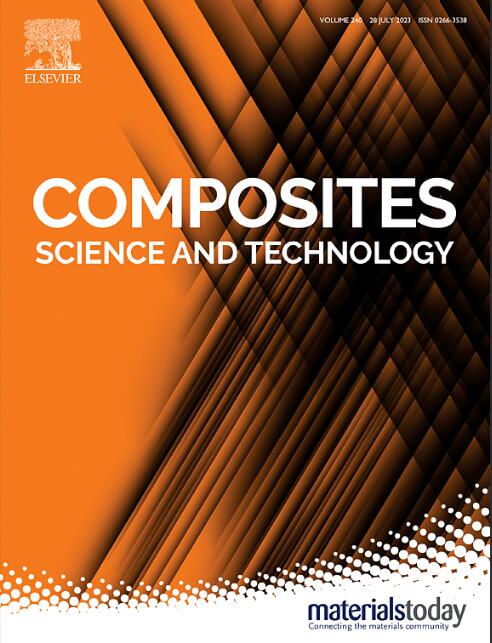Composite Janus film based on the synergistic interactions of π-π stacking and dynamic covalent bond toward direction recognition sensing
IF 8.3
1区 材料科学
Q1 MATERIALS SCIENCE, COMPOSITES
引用次数: 0
Abstract
Although flexible strain sensors have made important advancements recently, most of them are unable to recognize the direction of motion, which greatly limits their application in fields such as human-machine interaction. This paper presents the fabrication of a bilayer asymmetric composite film that exhibits Janus dual-sided characteristics and interfacial properties. Specifically, the two sides possess different chemical compositions and surface features. The strong π-π stacking interaction between carbon nanotubes (CNTs) and pyrene enables a tight coating on the surface of poly(glycidyl propyl urethane) (PGPU), resulting in excellent sensing capabilities and electromagnetic shielding properties for the composite material. This composite film can effectively monitor the amplitude and direction of motion. Firstly, pyrene-grafted polyurethane (PGPU) was synthesized including on dynamic covalent bonds. The tensile strength of different samples can reach up to 19.69 MPa, and the strain at break is up to 501.95 %. Furthermore, PGPU/CNTs conductive composite films were fabricated by spray-coating carbon nanotubes (CNTs) onto PGPU, and the pyrene units in PGPU can effectively interact with CNTs via π-π stacking, ensuring that stable adhesion of CNTs layer during long-term usage. Due to the dynamic covalent bonds and hydrogen bonds inside PGPU, PGPU and PGPU/CNTs both exhibit well-performed self-healing capability. Notably, the Janus structure of PGPU/CNTs can adjust the positive and negative values of relative resistance based on stretchable and compressive status of CNTs layer. Thus, PGPU/CNTs are directionally sensitive and self-healing flexible wearable sensor, which might apply in human-machine interaction field.

基于π-π堆叠和动态共价键协同作用的复合 Janus 膜,可实现方向识别传感
尽管柔性应变传感器近年来取得了重要进展,但它们大多无法识别运动方向,这极大地限制了它们在人机交互等领域的应用。本文介绍了一种双层非对称复合薄膜的制备方法,该薄膜具有杰纳斯双面特性和界面性能。具体来说,双面具有不同的化学成分和表面特征。碳纳米管(CNTs)与芘之间强烈的π-π堆叠作用使其能够紧密包覆在聚缩水甘油丙基聚氨酯(PGPU)表面,从而使复合材料具有出色的传感能力和电磁屏蔽性能。这种复合薄膜可以有效监测运动的振幅和方向。首先,利用动态共价键合成了芘接枝聚氨酯(PGPU)。不同样品的拉伸强度可达 19.69 兆帕,断裂应变高达 501.95 %。此外,通过在 PGPU 上喷涂碳纳米管 (CNT),制备出了 PGPU/CNTs 导电复合膜,PGPU 中的芘单元可通过 π-π 堆叠与 CNTs 有效作用,确保 CNTs 层在长期使用过程中的稳定粘附。由于 PGPU 内部存在动态共价键和氢键,因此 PGPU 和 PGPU/CNTs 都具有良好的自愈能力。值得注意的是,PGPU/CNTs 的 Janus 结构可根据 CNTs 层的拉伸和压缩状态调整相对电阻的正负值。因此,PGPU/CNT 是一种具有方向敏感性和自愈性的柔性可穿戴传感器,可应用于人机交互领域。
本文章由计算机程序翻译,如有差异,请以英文原文为准。
求助全文
约1分钟内获得全文
求助全文
来源期刊

Composites Science and Technology
工程技术-材料科学:复合
CiteScore
16.20
自引率
9.90%
发文量
611
审稿时长
33 days
期刊介绍:
Composites Science and Technology publishes refereed original articles on the fundamental and applied science of engineering composites. The focus of this journal is on polymeric matrix composites with reinforcements/fillers ranging from nano- to macro-scale. CSTE encourages manuscripts reporting unique, innovative contributions to the physics, chemistry, materials science and applied mechanics aspects of advanced composites.
Besides traditional fiber reinforced composites, novel composites with significant potential for engineering applications are encouraged.
 求助内容:
求助内容: 应助结果提醒方式:
应助结果提醒方式:


